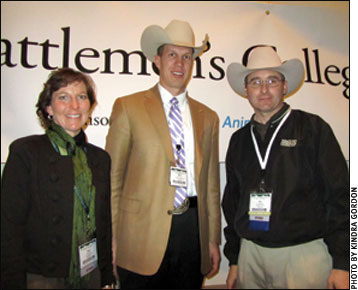Multigenerational Ranching
Three real families provide their tips for how to make it work.
by Kindra Gordon for Angus Productions Inc.
DENVER (Feb. 2, 2011) — Transitioning a family farm or ranch operation to include multiple generations requires planning, communication and determination — and every family is different, so there is no “one plan fits all” approach.

Sara Shields, Matt Perrier and Don Schiefelbein shared their insights for multi-generation ranching.
Multiple generations of family working together in business can get dramatic, admitted Matt Perrier, who represents the fifth generation at Dalebanks Angus Ranch, which was established in the late 1880s near Eureka, Kan. Perrier addressed the topic of “multi-generational ranching” during a Cattlemen’s College® session Feb. 2 during the Cattle Industry Convention in Denver.
Perrier was joined on the panel discussion by two others who shared their multi-generation ranch transition stories: Sara Shields, who operates San Isabel Ranch with her family near Westcliffe, Colo.; and Don Schiefelbein, who operates Schiefelbein Farms with his family near Kimball, Minn. From their experiences, they shared these tips for working together:
• All three agreed that the best thing they did before returning to the family operation was to get a college education and have a job away from home for a time.
“Our father’s No. 1 rule is that everyone must leave the ranch for a minimum of four years before coming into the family business,” said Schiefelbein, whose family operation includes a 650-head seedstock Angus herd and a 5,000-head cattle-feeding facility.
• As the next generation returns to the family operation, this trio also emphasized the importance of communication — among the family members and farm or ranch employees they work with, as well as the family members who are not actively working in the business.
Perrier said, “You’ve got to figure out what the best method is to communicate with those in your family and the operation.” He suggested this may be regular, formal meetings or some other format, but the goal is to keep everyone informed and allow them to offer input.
As well, communication should focus on discussing the business vision and goals — where is the operation now and what direction do you want to take it, he pointed out.
• As part of the communication process, a formal business structure and estate plan should be developed, suggested Shiefelbein. This can aid with tax planning, identifying job roles and clearly identifying the ownership structure and transition plan between the generations.
• Likewise, Shields emphasized the importance of sharing the ranch with family — parents and siblings — who maybe are no longer an active part of the business but still enjoy and feel connected to the land and livestock.
“Set aside time for relationships and remember to truly respect and enjoy one another,” she stated. The San Isabel Ranch has been in her family for 139 years.
• Shields added that a key to her family’s long-term success has been willingness to diversify. They’ve transitioned from a flock of ewes and a “rainbow” herd of cattle in the early days, to seedstock Herefords and now have added a bred heifer program, fall calving, custom haying and vacation rental on the ranch to their mix for added income. She emphasizes the need to analyze and evaluate opportunities as the needs of each generation change.
In her closing remarks, Shields shared that returning to a family operation and working with the generations can be rewarding, but it isn’t easy. “It requires communication and trust to figure each person’s role out.”
Schiefelbein and Perrier agreed. Perrier said, “It’s give and take. The older generation needs to accept and promote new ideas; and the younger generation needs to realize that sometimes their ideas may not be implemented. All generations need to have the rule: Don’t cuss, discuss.”
Working with a large family, Shiefelbein shared that one of their guiding principles is their “unselfish rule.” He explained, “Our rule is that it’s not about us; it’s about we. Our priority must be the long-term success of the ranch. Then we will all be successful.”
###
Editor’s Note: The above article was written under contract or by staff of Angus Productions Inc. (API). It may not be reprinted without express permission of API. To request reprint permision, contact the editor at 816-383-5200.
www.4cattlemen.com is an event coverage site provided by the editorial team at Angus Productions Inc. (API), publisher of the Angus Journal, the Angus Beef Bulletin, the Angus Beef Bulletin EXTRA and the Angus e-List. For questions about this site, to submit an article for our consideration, or to report a broken link, contact the editor at 816-383-5200; 3201 Frederick Ave., Saint Joseph, MO 64506.
API claims copyright to this web site as presented. We welcome educational venues and cattlemen to link to this site as a service to their audience.

